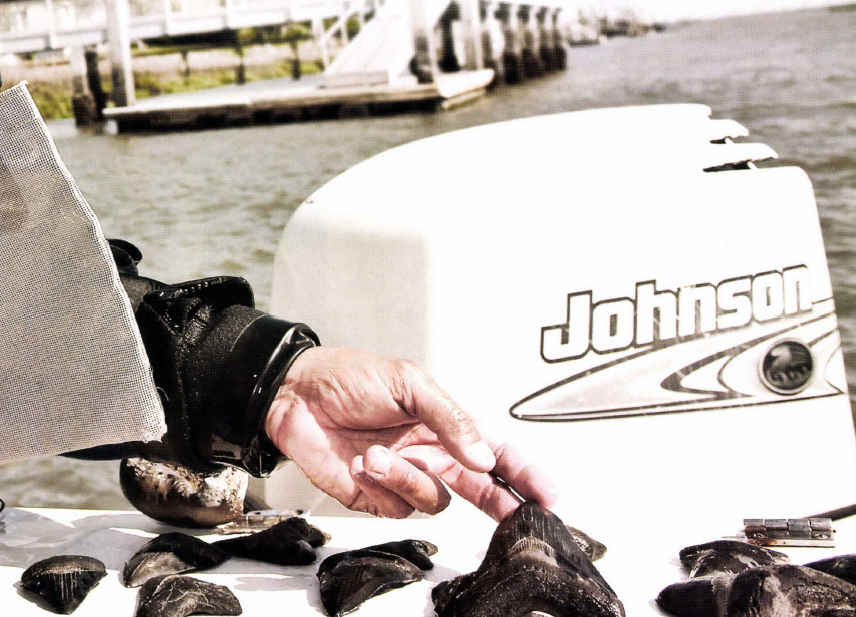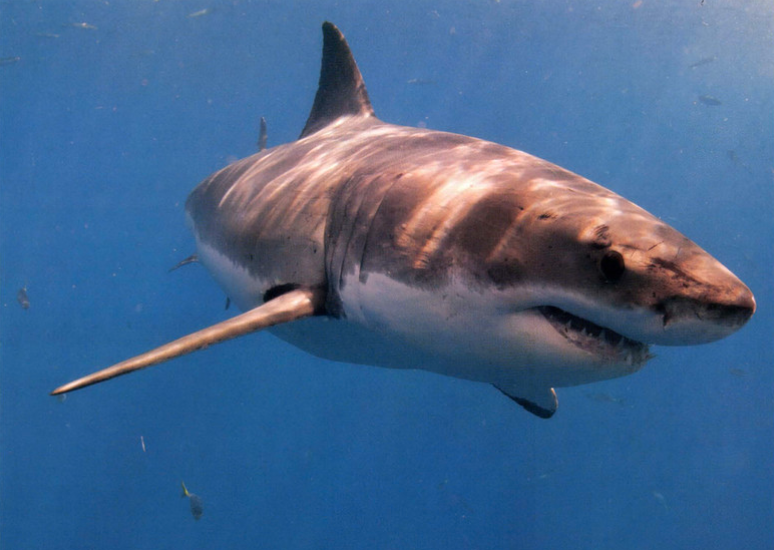For Bill Eberlein, every dive is an opportunity to discover a Megalodon tooth or some other fossil that has not seen the light of day in millions of years.
It is a universally acknowledged truth among fishermen, sportsmen and hopefully the general public, that one should never, ever, fish for sharks by hand.
You probably shouldn’t be in the water with the sharks either.
And if you are in water where you can’t see? Forget about it! But then there are folks who ditch this perfectly sound advice and do it anyway. The only catch is that the sharks are fossils, and the fishing tackle is SCUBA gear.
River diving for fossils is a popular venture among experienced, hardcore SCUBA divers. Most people take up diving to explore coral reefs in clear, tropical waters. But most fossil diving takes place in murky, current-laced rivers where the divers’ hands are their eyes.
As a seasoned diver myself, I have experienced enough low-visibility situations to learn that this is no laughing matter. Many of my SCUBA companions dive rivers for fossils and take every opportunity to regale me with stories of crawling along silt-laden river bottoms with nary a hand’s breadth of visibility, close encounters with alligators and wiggling out of deep, sticky mud while dodging boaters.
It takes a high level of training, an excess of caution and extremely steady nerves to keep from panicking at the loss of one’s most-used sense. These qualities make fossil diving simply a hobby for most, reserved for those with the disposable income or time.
Bill Eberlein, owner of MegaTeeth.com, is one of those lucky few who has turned his hobby into his livelihood. Growing up in Erie, Pennsylvania, he began diving the chilly waters of Lake Erie rather than the warm tropics that initially enthrall most recreational divers. His instructor, Sam Leo, led a search-and-rescue team, and Bill began volunteering a year after getting dive certified. With the search-and-rescue came extensive training as an ice diver, divemaster and dive instructor, all of which play into Bill’s current profession as a fossil diver.
“I’m Iucky to have learned to dive under Sam,” Bill remarks. “He taught me that there is good diving everywhere.”
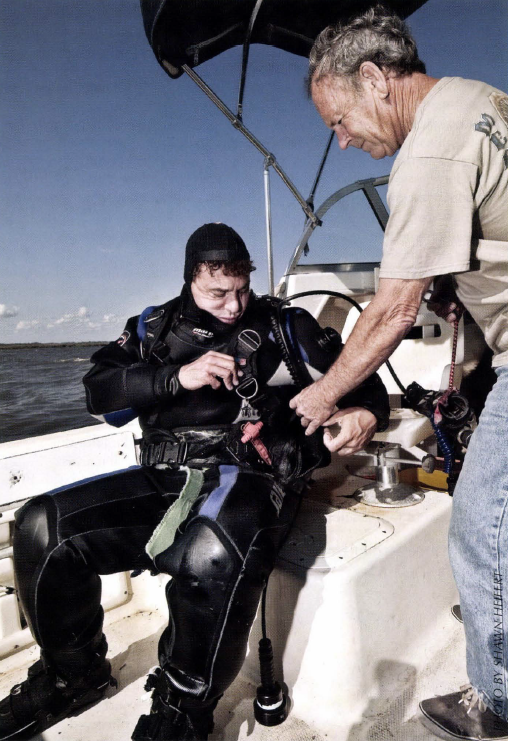
Bill Eberlein and his boat captain, Gene Ashley, prepare for another fossil hunt in the turbid waters of a coastal creek near Savannah, Georgia.
Bill will dive in any kind of water and often feels safer underwater than driving on the highway. After moving to Savannah, Georgia, in 1999, Bill took up fossil diving more intensely and has spent more than 11 years in the business. Aside from teaching the occasional accounting class at Savannah Technical College, he makes his living from selling the fossils that he finds while river diving – particularly Megalodon teeth.
Ask anyone what comes to mind at the mention of giant prehistoric sharks, and they will probably say, “Megalodon.”
“Scientists believe that the Megalodon evolved about fifteen million years ago and died off about two million years ago,” Bill says. Breaking the scale at 77 tons and measuring as much as 60 feet in length, the Megalodon hunted prehistoric whales with jaws that could swallow a small car.
Like modern-day sharks, Megalodon skeletons consisted almost entirely of cartilage, so their teeth, ranging from three to seven inches long, provide the only fossil evidence of their existence.
I recently had the opportunity to travel to Savannah to meet Bill in person. I arrived on a Wednesday evening and then joined Bill the following morning to take notes and photographs while he dove. Later, he and his fiancée met me for dinner at a great little local seafood restaurant, where I enjoyed several fascinating hours of conversation. Glancing at the big suitcase that Bill had brought into the restaurant, I knew I was in for a treat.
The three of us sat on the patio enjoying the pleasant autumn evening and had barely ordered before Bill started breaking out the fossils. Much to our waitress’ amusement, Bill and I shamelessly took over half of the empty patio to photograph museum-quality Megalodon teeth, mastodon molars, crocodile jawbones and other ancient treasures that had me as giddy as the little girl who used to look forward to visiting the Smithsonian specifically to see the dinosaur fossils.
He even brought his all-time favorite find – a seven-inch Megalodon tooth in pristine condition that dwarfed my hand. Word apparently spread about our presence, and jaws dropped left and right as waitresses and patrons stopped by our table asking to peek at the fossils.
The conversation flowed easily. We weren’t merely the journalist and subject in an interview, but rather two divers sharing stories of their adventures. Bill’s fiancée proudly proclaims herself as his biggest fan, and while his family members have a healthy concern for his safety, they’re all supportive and often ask about his latest finds.
When I asked about his most unusual experiences, he recounted diving 60 feet in the mouth of a river near the ocean when something grabbed his fin and held on until he tore loose from whatever-it-was with a well-placed kick. It disappeared momentarily, then grabbed his fin again and spun him 90 degrees. Once again, he kicked himself free and began feeling his way back toward the boat.
“Then I started finding all sorts of shark teeth,” he admitted with a grin, “and I thought, ‘Well, I’m already here, so might as well keep going.'”
He never found out what grabbed him, and his fin bore no tooth marks to give any clues.
I met Bill and his boat captain, Gene Ashley, the following morning at the local marina. Captain Gene has worked with Bill for the past eight years and is his single biggest safety precaution. Low visibility diving practically eliminates the buddy system, so Bill relies on Gene to be his topside eyes and to keep the boat nearby when he surfaces. The well-practiced rapport between them was obvious while Gene wordlessly helped Bill gear up, just as they’ve done a thousand times.
We stayed within the protective confines of the estuaries due to choppier conditions closer to the ocean. But Bill often experienced good luck from this spot and felt optimistic. He slowly rolled backward off the side of the boat into the water, and the last we saw of him was the glow of his dive light as it melted into the murky water.
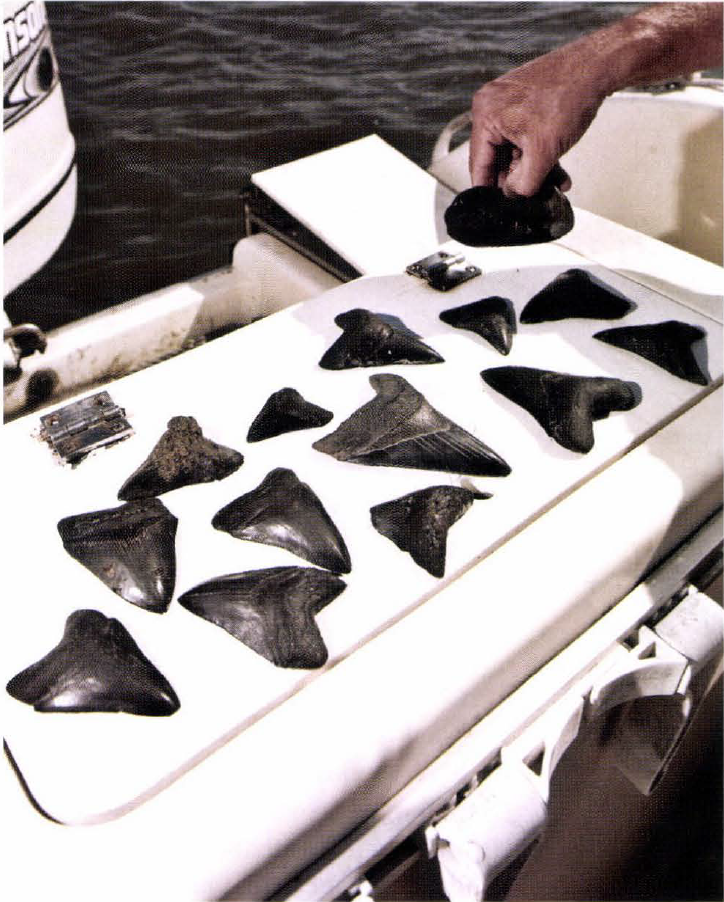
Eberlein found all of these Megalodon shark teeth in a single day of diving.
That left Gene and me, ever watchful, with nearly two hours to kill. We discussed the shrimp season, swapped fishing stories and compared notes on our favorite seafood. Even after years spent working as a boat captain, Gene never gets bored and loves being on the water.
“I don’t know of anyone who loves his job more than Bill does…besides me!”
Time seemed to fly, and before I knew it came the call.
“He’s up!” Gene spotted Bill before I did, and he wheeled the boat around to retrieve him. Bill handed up his mesh bag, bulging with the telltale clatter of fossils. I felt honored to be among the first to behold these relics in millions of years.
Shark tooth fragments, prehistoric horse teeth, fishtail vertebrae and, best of all, intact Megalodon teeth were laid out along the captain’s chair and adjacent footrest. The finest prize of the day was a five-inch Megalodon tooth, the root totally intact, the fossilized enamel flawless, and the serrated tip and edges still sharp enough to prick an unsuspecting finger.
But Bill Eberlein was already anticipating the next day, the next dive and the next ancient treasures to find. And that’s what keeps him diving year-round in wetsuits, dry suits and under any conditions. Every dive is an opportunity to discover something that has not seen the light of day in eons. For when your boss is a prehistoric shark and your office is the water, it’s a fine life to lead.
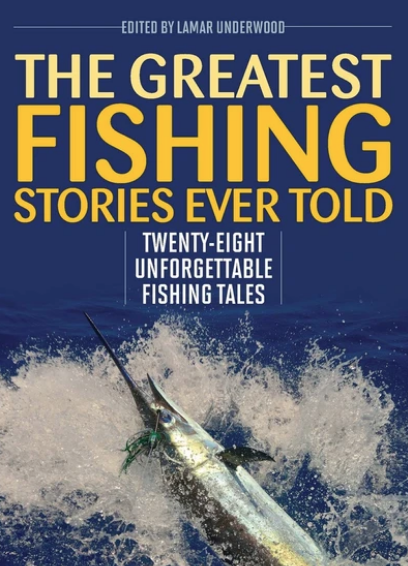 The Greatest Fishing Stories Ever Told is sure to ignite recollections of your own angling experiences as well as send your imagination adrift. In this compilation of tales you will read about two kinds of places, the ones you have been to before and love to remember, and the places you have only dreamed of going, and would love to visit. Whether you prefer to fish rivers, estuaries, or beaches, this book will take you to all kinds of water, where you’ll experience catching every kind of fish. Buy Now
The Greatest Fishing Stories Ever Told is sure to ignite recollections of your own angling experiences as well as send your imagination adrift. In this compilation of tales you will read about two kinds of places, the ones you have been to before and love to remember, and the places you have only dreamed of going, and would love to visit. Whether you prefer to fish rivers, estuaries, or beaches, this book will take you to all kinds of water, where you’ll experience catching every kind of fish. Buy Now

